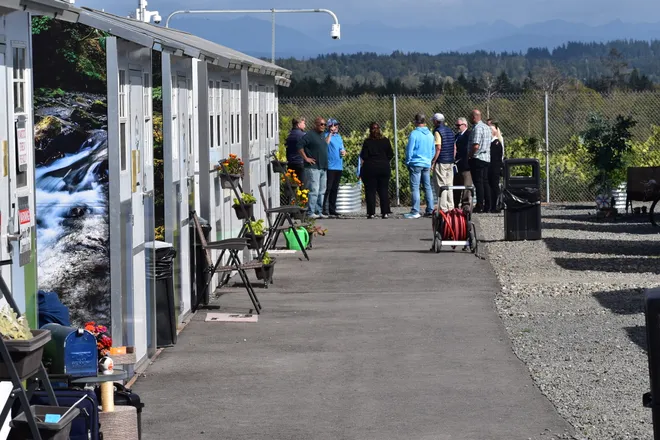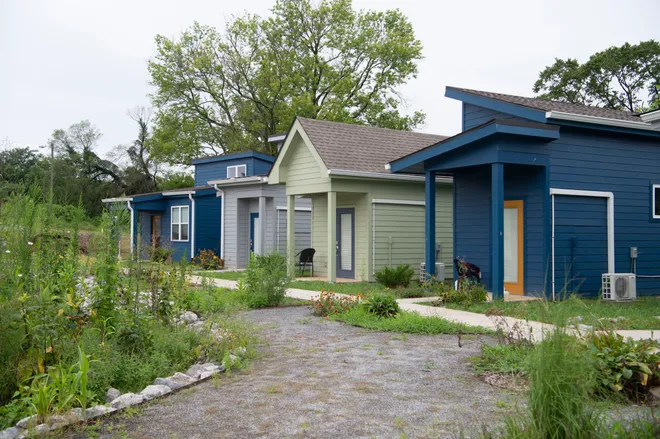With homelessness high, California tries an unorthodox solution: Tiny house villages
Across California, and the Western U.S., more cities are erecting tiny home villages for unhoused residents to quickly get people indoors and connect them to basic resources like electricity.
Last week, California Gov. Gavin Newsom announced 300 tiny homes planned for Sacramento will be put in an abandoned office park and the state fair grounds. Another 900 tiny homes from the governor will go up on a parcel of land in San Jose and to-be-determined locations in Los Angeles and San Diego. Newsom first announced the plan for the 1,200 homes in March.
The structures — which are around 100 square feet — are one of the latest solutions to America's homeless crisis, in which local leaders across the country are trying to get tens of thousands of residents from the streets indoors to homeless shelters, temporary hotel rooms or apartments paid for by government vouchers.
But the problem is enormous: Over 580,000 Americans live without adequate shelter and about a third of them are in California. Those numbers are also growing, because a rising tide of evictions and sharp increases in rents in booming markets push more people into homelessness every day.

In Los Angeles, hundreds of residents have moved from the streets into tiny homes as part of Mayor Karen Bass' housing push in recent months. But some say they feel coerced, because they're forced to give up belongings, like tents, before they can be taken to a tiny home neighborhood. Some are required to pair with random roommates and some couples are separated, according to Carla Orendorff, a homeless advocate in Los Angeles' Van Nuys neighborhood.
"They call it housing pretty confidently, but once people are put into tiny homes there aren't many services that are being offered," Orendorff said. "They're kind of being put in a waiting room."

Tiny homes planned in Sacramento
After delays, Newsom announced this week that 175 tiny homes will be placed in a 13-acre abandoned office park in South Sacramento, and 175 will be placed on state fair grounds. But those homes haven’t been built, and the state has yet to award any contracts for builders, the Sacramento Bee reported.
The announcement comes one month after Sacramento's top prosecutor sued the city over its failure to clean up homeless encampments. Sacramento County had nearly 9,300 homeless people in 2022.
In his announcement of the lawsuit, Sacramento County District Attorney Thien Ho said the city's unhoused population has "exploded to over 250%" over the last seven years.
The planned tiny homes are an important piece of the state's broader push to reduce homelessness because they allow government officials to shelter large numbers of people quickly, Sacramento Mayor Darrell Steinberg told USA TODAY.
"When you can produce housing faster and much less expensively, we ought to be doing a whole lot more of it," he said.
Sacramento County opened its first tiny home village, which includes 100 structures, as part of its Safe Stay program in August.

Steinberg said officials should be scheduled to break ground on the abandoned office park site along South Sacramento's Stockton Boulevard corridor by the end of 2023.
At the site, which will be "intended as transitional housing," people can access mental health and substance use services, and "vocational rehabilitation," Steinberg said.
"People who have been out on the streets for a long time often need a transitional place to achieve stability before they're ready for permanent housing — not everyone," he said.
In San Jose, 200 tiny homes will eventually go on a 7.2-acre lot owned by the Santa Clara Valley Transportation Authority.
Newsom's administration has not said when it will begin work on the state-gifted tiny homes planned for Los Angeles and San Diego.
Hundreds placed in tiny homes in Los Angeles
Homeless residents have moved into tiny homes in Los Angeles for more than two years, after the county opened one of its first villages in North Hollywood in early 2021.
This year, Los Angeles ramped up construction as part of Mayor Karen Bass' Inside Safe program, which aims to get 17,000 unhoused people off the streets by December, which marks one year since Bass took office. Across Los Angeles County, an estimated 75,500 people live without proper shelter, sleeping outside in vehicles or in unsafe buildings, according to the Los Angeles Homeless Services Authority.
Orendorff said she's long felt the city's tiny home effort allows officials to "criminalize people more easily," because the tiny homes were erected while municipalities passed ordinances across Los Angeles County criminalizing tents and sleeping or lying outside.
Curfews and special enforcement zones surrounding tiny home neighborhoods can make the communities feel "carceral," Orendorff said.
Though the tiny home villages come with rules and restrictions, they are better than the alternative of leaving people on the streets, Steinberg said.
"We want everybody to have a full opportunity to live in whatever kind of housing they choose to live in, but we have a crisis, and we're not producing enough conventional housing fast enough to meet the need," he said.
Denver expands tiny home program
This week Denver broke ground on a site that will include 120 tiny homes for people experiencing homelessness.
The groundbreaking comes after Denver Mayor Mike Johnston announced plans this year to house 1,000 homeless people by the end of 2023.
Each of the homes will be between 70 and 120 square feet, ABC 7 in Denver reported, and the site is on land owned by the state transportation department.
Arizona group makes tiny homes from shipping containers
In Tucson, Arizona, a faith-based nonprofit is making tiny homes out of shipping containers from Arizona Governor Doug Ducey's makeshift border wall.
The homes will be assigned to young people aging out of foster care — a time when many new adults become homeless as they exit the child protective services without having housing lined up.
Bryan Benz, the founder and CEO of Wholistic Transformation, said each tiny home will be a one-bedroom house, with a full kitchen, bathroom, and washer and dryer. The residents will choose what it will look like inside, from the style of cabinets to the color and fabric of the couch cushions.
Austin has had tiny homes for almost a decade
Austin's Community First Village opened in 2015 to house formerly homeless residents, and tiny home projects have continued to expand in the Lone Star State's capital since.
This years, Travis County approved a $35 million contract with the nonprofit Mobile Loaves and Fishes to create nearly 500 tiny homes and other forms of shelter.
Contributing: Thao Nguyen, Minnah Arshad, USA TODAY; Sarah Lapidus, Arizona Republic; Associated Press
Disclaimer: The copyright of this article belongs to the original author. Reposting this article is solely for the purpose of information dissemination and does not constitute any investment advice. If there is any infringement, please contact us immediately. We will make corrections or deletions as necessary. Thank you.







